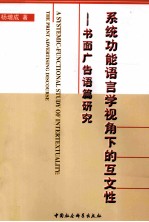
- 作 者:杨增成著
- 出 版 社:北京:中国社会科学出版社
- 出版年份:2012
- ISBN:9787516116784
- 标注页数:230 页
- PDF页数:246 页
请阅读订购服务说明与试读!
订购服务说明
1、本站所有的书默认都是PDF格式,该格式图书只能阅读和打印,不能再次编辑。
2、除分上下册或者多册的情况下,一般PDF页数一定要大于标注页数才建议下单购买。【本资源246 ≥230页】
图书下载及付费说明
1、所有的电子图书为PDF格式,支持电脑、手机、平板等各类电子设备阅读;可以任意拷贝文件到不同的阅读设备里进行阅读。
2、电子图书在提交订单后一般半小时内处理完成,最晚48小时内处理完成。(非工作日购买会延迟)
3、所有的电子图书都是原书直接扫描方式制作而成。
Chapter 1 Introduction 1
1.1 The Research Topic 1
1.2 Rationale for the Present Study 3
1.3 Objectives of this Research 4
1.4 Data and Methodology 5
1.5 Organization of this Book 13
Chapter 2 Previous Researches on Intertextuality 15
2.1 The Origin of the Theory of Intertextuality 15
2.2 The Literary Study of Intertextuality 18
2.3 The Study of Intertextuality in Arts 22
2.4 The Study of Intertextuality in Linguistics 23
2.5 The Linguistic Studies of Some of the Specific Forms of Inter-textuality 27
2. 6 Summary 33
Chapter 3 A Systemic - Functional Model for the Study of Inter-textuality 37
3.1 Approaches to Discourse Analysis 38
3.2 A Systemic - Functional Approach to Discourse Analysis 40
3. 3 A Systemic - Functional Model for the Study of Intertextuality 45
Chapter 4 The Relationship Between Intertextuality and Context 49
4.1 Contextual Variables 49
4.2 The Relationship Between Discourse and Context 54
4.3 The Contextual Factors for the PAD 56
4.4 The Relationship Between Intertextuality and Context 59
Chapter 5 The Experiential Meaning in the Discourse Involving Intertextuality 71
5.1 The Dialogieal Relations Among the Voices 71
5.2 The Experiential Meaning Expressed by Lexicon 79
5.3 Linguistic Analysis of Process 86
Chapter 6 The Interpersonal Meaning in the Discourse Involving Intertextuality 103
6. 1 The Participant Relationship 103
6. 2 The Appraisals in the PAD 132
6. 3 The Mood in the Discourse Involving Intertextuality 151
Chapter 7 Linking Different Voices in Discourses Involving Inter-textuality 161
7. 1 Generic Structure 161
7.2 Texture 179
7.3 Linking Voices through Sentence Structure 196
7. 4 Coherence in the Discourse Involving Intertextuality 198
Chapter 8 Conclusions 209
8.1 Major Findings 209
8.2 Implications 211
Bibliography 213
Acknowledgements 229
